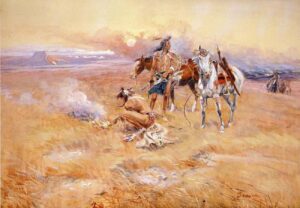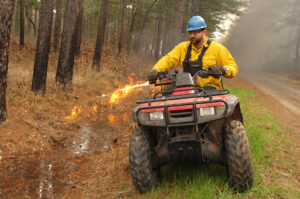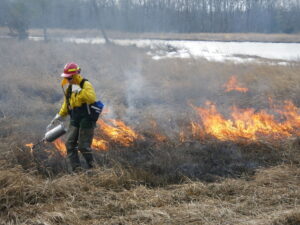 With the many annual wildfires that continue to consume many of the western areas of the United States each year, we begin to wonder if there is any way to stop the madness. Of course, these days, firefighters knw about mitigation, “a series of steps that you can take to reduce the risk of a wildfire consuming your property. It includes assessing the risks around your property, recognizing the wildfire dangers and your responsibility in mitigating them, thereby creating a defensible space. It involves how and where you store materials around your property, considering the health of your trees to determine the need for trimming or removal, as well as designating 3 zones of protection (0-30’, 30-100’, 100’+) in your defensible space.” That’s how we would help to stop the threat of fire these days, but where did we even learn about this. I can’t say for sure, but we can look to the American Indians for some possible clues.
With the many annual wildfires that continue to consume many of the western areas of the United States each year, we begin to wonder if there is any way to stop the madness. Of course, these days, firefighters knw about mitigation, “a series of steps that you can take to reduce the risk of a wildfire consuming your property. It includes assessing the risks around your property, recognizing the wildfire dangers and your responsibility in mitigating them, thereby creating a defensible space. It involves how and where you store materials around your property, considering the health of your trees to determine the need for trimming or removal, as well as designating 3 zones of protection (0-30’, 30-100’, 100’+) in your defensible space.” That’s how we would help to stop the threat of fire these days, but where did we even learn about this. I can’t say for sure, but we can look to the American Indians for some possible clues.
For centuries, Europeans and Americans thought or at least claimed to have thought that the myth that Native Americans were solely hunter-gatherers who didn’t know how to make the most of the land was a reality. That really isn’t the case at all, but the story gave the White settlers, permission to have every right to take over large parcels of land, on the premise that it would have gone to waste otherwise. I’m sure it seemed like a  logical way to get more land, and the settlers didn’t see the Indians as really using the land anyway, but then did the settlers really know anything about the land. I don’t think so.
logical way to get more land, and the settlers didn’t see the Indians as really using the land anyway, but then did the settlers really know anything about the land. I don’t think so.
The idea that the Indians didn’t really know how to work the land is a total misrepresentation of the complex relationship between Indigenous communities and their land. In reality the Native Americans were actually farmers with extensive agricultural experience. In fact, it was the Pilgrims who struggled to survive after they arrived what is now Massachusetts. The locals…the Wampanoag were the ones who actually taught them how to farm. Strangely, one of the most innovative and effective land-management strategies of the Wampanoag people was “cultural burning,” which is igniting small, controlled fires that burn away old, dry vegetation to make room for new life. Cultural Burning sounds a whole lot like the fire mitigation practices of today. Of course, it is different, but in some ways, it is also the same. While the exact steps are not the same, the outcome can be very much the same.
Cultural burning reduced the chance of large fires that would kill people and food sources, including the animals that the Indians hunted, and the natural food sources they depended on. When we neglect fire mitigation practices, we open the area up to highly dangerous fires that destroy homes and kill people every year. The fire  mitigation practices are different these days, but just like the protections the Indians used, the current fire mitigation practices could save lives, if they were properly carried out. The result of improper fire mitigation or even a ack of fire mitigation can be seen in the many annual wildfires we see in places like present day California…sadly. Though the practice of cultural burning was stopped in the 19th and 20th centuries, it’s coming back into practice in some areas, especially as conservationists understand its value in preventing more devastating, larger wildfires. Wildfires can’t spread in areas of controlled burns. When vegetation has already been burned away in controlled blazes, wildfires have fewer places to spread.
mitigation practices are different these days, but just like the protections the Indians used, the current fire mitigation practices could save lives, if they were properly carried out. The result of improper fire mitigation or even a ack of fire mitigation can be seen in the many annual wildfires we see in places like present day California…sadly. Though the practice of cultural burning was stopped in the 19th and 20th centuries, it’s coming back into practice in some areas, especially as conservationists understand its value in preventing more devastating, larger wildfires. Wildfires can’t spread in areas of controlled burns. When vegetation has already been burned away in controlled blazes, wildfires have fewer places to spread.


Leave a Reply